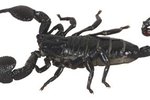The best way to distinguish between mature male and female sharks is by looking for the presence of external sexual organs, called claspers. Those with claspers are mature males; those without claspers are either females or immature males. You can also consider other criteria, such as the presence of mating scars, to determine a shark's sex. Males and females of some species exhibit different body shapes, sizes and skin characteristics; however, these criteria are rarely pronounced enough to serve as useful criteria for distinguishing between the sexes.
Claspers
Unlike most other fish, who practice a method of external fertilization (called spawning), all living sharks practice internal fertilization. To accomplish this, the male inserts one of his claspers into the female’s cloaca. He then releases sperm, which travel up the female’s reproductive tract, and fertilize the egg. The claspers take some time to develop, so they can be difficult to find on juvenile males.
The Scars of Love
During the process of mating, male sharks usually bite the females. This allows the male to anchor himself and apply enough force to insert one of his claspers into her body. Often, these bites leave scars on the females that may last for many years.
This reproductive strategy has caused the females of some species to develop thicker skin than males have. A 2013 study, published in “PLOS One,” determined that female lesser-spotted catsharks (Scyliorhinus canicula) have different dermal denticles (small tooth-like structures on the surface of shark skin). These denticles presumably offer females some protection from the bites of males.
Size and Shape
Females grow larger than males in many large, live-bearing species, such as shortfin makos (Isurus oxyrinchus) and great whites (Carcharodon carcharias). By contrast, egg-laying species generally have similarly sized males and females, or the males are slightly larger.
In keeping with this pattern, male blacktip sawtail catsharks (Galeus sauteri), which are an egg-laying species, reach slightly larger sizes than do females. Additionally, catsharks exhibit very subtle differences in head shape and mouth size, but, as with total length, the differences are too minor to provide reliable clues for aquarists. However, at least one species – the bonnethead shark (Sphyrna tiburo) – exhibits strongly different head shapes. The males of the species have a definitive protrusion on the front of their heads, called the cephalic bulge, which females lack.





